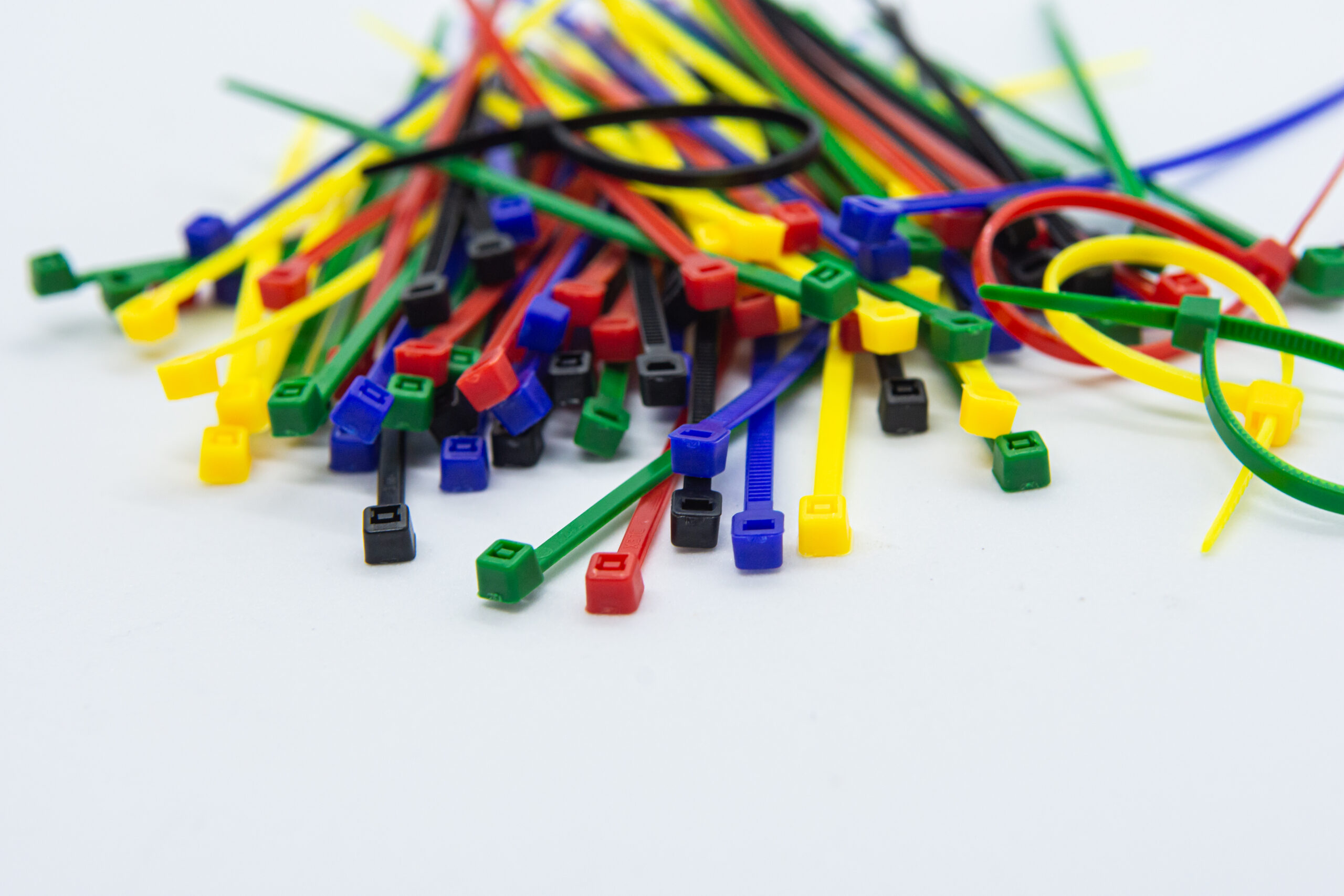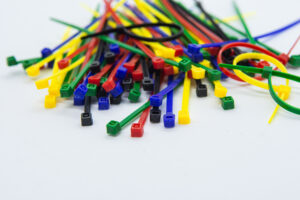What Are Cable Ties?
A cable tie is a plastic fastening tool that is typically used to bundle together and secure cables, wires, and cords. The most common form is a strip of plastic with a ratcheted locking mechanism that allows the tie to tighten as needed. Once tightened, the cable tie stays in place, holding the cables together or securing objects to a surface.
They come in different sizes, materials, and colors, making them adaptable for a wide range of tasks. Whether you need to keep your cables neat, secure heavy-duty items, or even organize things around the house, there’s likely a cable tie for the job.
Different Types of Cable Ties
Cable ties aren’t a one-size-fits-all tool. There are several types to choose from depending on the job:
- Standard Cable Ties: The classic option, usually made of nylon or polymer. These are great for light to medium-duty applications like bundling cables or organizing wires.
- Heavy-Duty Cable Ties: Designed for more demanding tasks, such as holding larger bundles of cables or securing outdoor equipment. These are often made from more durable materials like stainless steel or UV-resistant plastics.
- Releasable Cable Ties: These can be undone and reused, which is perfect for tasks where you need to adjust or change things frequently, like cable management.
- Colored Cable Ties: Available in various colors, these ties can be used for color-coding wires or simply adding a bit of aesthetic organization.
- Mountable Cable Ties: These have a mounting hole and are designed to be attached to surfaces for better organization. They’re perfect for securing cables along walls or under desks.
Why Are Cable Ties So Useful?
Cable ties may seem like a small, inexpensive item, but their versatility makes them invaluable for a range of applications:
- Organization: From cables and wires to organizing garden tools or bags, cable ties help declutter spaces and maintain neatness.
- Cost-Effective: They’re affordable, and because they come in bulk, they’re a budget-friendly solution for home, office, or industrial organization.
- Strong and Secure: Once tightened, cable ties hold objects in place firmly, making them reliable for various jobs.
- Space-Saving: Bundling cables and wires helps prevent tangles and maximizes space in areas where cables are used.
- Quick and Easy: They’re easy to use, making them an ideal solution for quick fixes or temporary solutions.
Common Uses for Cable Ties
Now that we’ve covered what cable ties are, let’s dive into some practical uses. You’ll be surprised at how many things they can help with!
1. Cable Management
One of the most obvious uses of cable ties is to keep your cables organized. Whether it’s computer cords, television wires, or home theater systems, cable ties prevent tangles, improve safety, and make everything look neater. You can bundle cables together, secure them along walls, or organize cords under your desk.
2. Securing Items Around the House
Need to keep your broom, mop, or gardening tools organized? Cable ties can help. Simply bundle your tools together or use the ties to attach them to hooks or shelves. For larger items, mountable cable ties can be used to attach them to walls.
3. Securing Outdoor Items
In the garden, cable ties can be used to support plants, keep hoses together, or secure garden decorations. They can also be used to attach outdoor lights or hanging baskets to fences or posts.
4. Home Repairs
Cable ties are often used to hold materials in place temporarily while you work. From keeping wood beams together to helping install insulation, these ties are handy in various construction or craft projects. They can also serve as a quick fix for loose parts until a more permanent solution is found.
5. Travel Organization
When you’re traveling, cable ties can help keep your luggage organized. Bundle similar items together, like electronics or chargers, and use them to keep things from shifting around. You can even use them to zip up your suitcase in a pinch if the zipper breaks!
6. Keeping Cables and Wires Safe
Use cable ties to secure loose wires that might be a tripping hazard. Whether in the garage, office, or even under the kitchen sink, you can keep wires out of the way and prevent accidents.
7. Tying Up Bags and Packages
Cable ties are useful for sealing up bags, whether they’re food storage bags, garbage bags, or bags of snacks. They create a secure seal and are much stronger than twist ties or rubber bands.
8. Emergency Fixes
Cable ties are great for quick fixes in emergency situations. Whether you need to secure a loose part of your car, temporarily fix broken equipment, or seal up broken boxes, a cable tie can be a lifesaver in times of need.
9. Hanging Decorations
Cable ties can be used for attaching lightweight decorations to fences, trees, or posts. They’re also great for securing banners or streamers when decorating for parties or events.
How to Use Cable Ties Effectively
Using cable ties is simple, but to ensure you’re doing it correctly and getting the most out of them, here are a few tips:
Don’t Over-tighten: While it may seem tempting to tighten the tie as much as possible, over-tightening can cause damage to the wires or cables you’re securing.
Cut Excess Length: After tightening the cable tie, use scissors or wire cutters to trim off the excess length. This keeps everything neat and tidy.
Use Multiple Ties for Larger Bundles: If you’re bundling a large group of cables or heavy items, don’t hesitate to use several cable ties for added security.
Choose the Right Size: Make sure you choose a cable tie that fits your job. For small cables, use smaller ties, and for larger bundles, opt for heavy-duty ties.
Conclusion
Cable ties are an unsung hero in the world of organization. With their simple design, they serve a variety of purposes—helping to keep your home, office, and outdoor spaces neat and organized. From securing cables to quick repairs, these versatile tools are indispensable. So, next time you’re looking for a simple solution to a cluttered mess or need a temporary fix, reach for a cable tie—it might just be the easiest answer!






